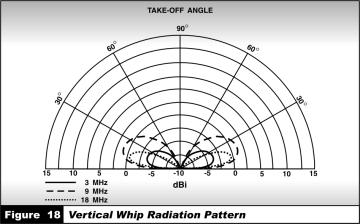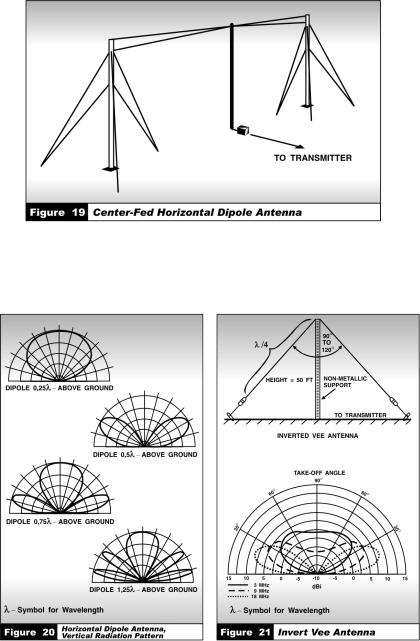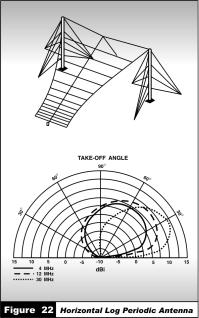
Учебное пособие 1751
.pdf1. Some of the most commonly |
Некоторые |
|
из |
часто |
||||||||
used terms to describe antennas |
используемых |
|
терминов |
|||||||||
are |
impedance, |
gain, radiation |
описания |
антенн |
– |
это |
||||||
pattern, take-off angle, and |
импеданс, |
|
коэффициент |
|||||||||
polarization. |
|
|
|
|
усиления, |
|
|
диаграмма |
||||
|
|
|
|
|
|
|
излучения, угол помех и |
|||||
|
|
|
|
|
|
|
поляризация. |
|
|
|
||
2. |
Most |
transmitters |
are |
Большинство |
передатчиков |
|||||||
designed to provide maximum |
сконструированы так, чтобы |
|||||||||||
output |
power |
and |
efficiency |
обеспечить |
|
максимальную |
||||||
into a 50-Ohm load. |
|
|
мощность |
и эффективность |
||||||||
|
|
|
|
|
|
|
при нагрузке 50 Ом. |
|
|
|||
3. The gain of antenna is a |
Усиление антенны – это мера |
|||||||||||
measure of its directivity. |
|
ее направленности. |
|
|
||||||||
4. |
|
In |
|
determining |
При |
определении |
диапазона |
|||||
communications range, |
it is |
связи |
важно |
принимать |
во |
|||||||
important to factor in the take- |
внимание угол помех, который |
|||||||||||
off angle, which is the angle |
является углом между главным |
|||||||||||
between the main lobe of an |
лепестком |
|
|
диаграммы |
||||||||
antenna |
pattern |
and |
the |
направленности |
антенны |
и |
||||||
horizontal |
plane |
of |
the |
горизонтальной |
|
плоскостью |
||||||
transmitting antenna. |
|
|
передающей антенны. |
|
||||||||
Task 58. Answer the following questions:
1.What are the most commonly used terms to describe antennas?
2.What does the impedance depend upon?
3.What is a unit of measurement of resistance?
4.What is the main challenge in radio communications?
5.Directivity is an ability to focus the energy the antenna radiates in a particular direction, isn't it?
6.What do you know about the gain of antenna?
7.Is a radiation pattern of an antenna characterized by lobes and nulls?
8.Are lobes areas of weak or strong radiation?
51

9. Why should transmitting and receiving antennas have the same polarization for best results?
Task 59. Match up the words with their definitions.
gain |
emission of energy |
|
|
|
|
impedance |
A property of volume; |
|
effective power |
||
|
||
|
a property of waves that describes the |
|
radiation |
direction of electromagnetic field or various |
|
|
oscillations |
|
output power |
opposition in an electrical circuit to the blow |
|
of an alternating current |
||
|
||
|
|
|
|
the amount of increase in signal power or |
|
polarization |
voltage or current expressed as the ratio of |
|
output to input |
||
|
||
|
|
Task 60. Which of the following do you think is true (T) or false (F)?
1.Some of the most commonly used terms to describe antennas are impedance, gain, radiation pattern, take-off angle and polarization.
2.The impedance depends upon take-off angle.
3.All antennas are connected directly to transmitters.
4.The gain of the antenna is a measure of load.
5.Transmitting antenna gain directly affects transmitter power requirements.
6.Radiation pattern is not determined by antennas design.
7.Take-off angle is the angle between the main lobe of antenna pattern and the horizontal plane of the transmitting antenna.
52

ACTIVITY 4
Text 2.4: TYPES OF ANTENNAS
Grammar: ARTICLES
Task 61. Study the types of articles.
The types of articles |
EXAMPLE |
|
|
|
a, an |
The indefinite article |
There is a countless variety of antennas |
used in HF communications. An inverted |
|
|
vee produces a communication of horizontal |
|
and vertical radiation. |
|
|
|
the |
The definite article |
One of the most versatile types of HF |
antenna is the half-wave dipole. The |
|
|
radiation pattern can change dramatically as |
|
a function of its distance above the ground. |
|
|
Task 62. Fill in the proper articles. |
|
|
|
|
|
|
||||||||
1. |
There is |
|
great variety of antennas used in mobile phones. |
|||||||||||
2. |
|
typical vertical whip radiation pattern is shown in |
|
figure. |
||||||||||
3. |
|
reflector consists of |
|
second vertical whip. |
|
Reflector can |
||||||||
|
add directivity to |
|
radiation pattern of |
|
whip. |
|
|
|||||||
4. |
In figure you can see |
center-fed horizontal dipole antenna. |
||||||||||||
|
|
|
|
|
|
|
|
|
|
|
|
|
|
|
53

Task 63. Read the following text and translate using a dictionary:
TEXT 2.4:
TYPES OF ANTENNAS
1.There is a countless variety of antennas used in HF communication. We’ll focus here on just some of the more common types.
2.The vertical whip antenna is usually adequate for ground wave circuits, since it is omnidirectional, has low take-off angles, and is vertically polarized. A typical vertical whip radiation pattern is shown in figure 18. A reflector, consisting of a second vertical whip, can add directivity to the radiation pattern of a whip.
3. One of the most versatile types of HF antenna is the half-wave dipole, which is basically a length of wire equal to one-half the transmitting wavelength.
The dipole can be oriented to provide either horizontal or vertical (centerfed) polarization. Figure 19 shows a center-fed horizontal dipole antenna.
The radiation pattern can change dramatically as a function of its distance above the ground. Figure 20 shows the vertical radiation pattern of a horizontal dipole for several values of its height (in terms of transmitting wavelength) above the ground.
54

4. A vertical dipole can often be used effectively on ships or vehicles. An inverted vee (sometimes called a “drooping dipole”) produces a combination of horizontal and vertical radiation with omnidirectional coverage. See figure 21.
55

5.Directional antennas range from simple single-wire configurations like the inverted vee to elaborate multi-wire arrays, including horizontal and vertical log periodic systems (see figure 22). Directional antennas are often used in point-to-point links. In systems requiring point-to- point communications to widely dispersed stations, rotatable directional antennas maybe used.
6.Sky wave communications between relatively closely spaced stations may require antennas specially designed for this purpose. These near vertical incidence sky wave (NVIS) antennas have a very high take-off angle, radiating RF energy nearly straight up. The radio waves refract downward to the earth in a circular pattern. NVIS antennas provide omnidirectional coverage out to about 600 km.
Task 64. Comprehension check:
1.How many antennas are there?
2.What is the vertical whip type of antenna?
3.Which of the most versatile types of HF antennas do you know?
4.Where can a vertical dipole be used?
56
5.What do you know about directional antennas?
6.Are the directional antennas often used in point-to-point links?
7.Which functions do sky wave communications perform?
8.The radio waves refract downward to the earth in a circular pattern, don't they?
Task 65. Study the sentences and practise in the translation with your partner.
1. |
The vertical whip antenna is |
Вертикальная |
штыревая |
антенна |
||||||||||
usually |
adequate |
for |
ground |
обычно подходит для варианта с |
||||||||||
wave circuits since it is |
наземными волнами, т.к. она |
|||||||||||||
omnidirectional. |
|
|
|
|
всенаправленная. |
|
|
|
||||||
|
|
|
|
|
||||||||||
2. |
The dipole can be oriented to |
Дипольная |
антенна |
может быть |
||||||||||
provide |
either |
horizontal |
or |
ориентирована |
для |
обеспечения |
||||||||
vertical (centre-fed) polarization. |
либо |
горизонтальной, |
либо |
|||||||||||
|
|
|
|
|
|
|
|
вертикальной |
(по |
|
центру) |
|||
|
|
|
|
|
|
|
|
поляризации. |
|
|
|
|
||
|
|
|
|
|
||||||||||
3. |
The radiation pattern can |
Диаграмма |
|
направленного |
||||||||||
change |
|
dramatically |
as |
a |
излучения |
|
может |
сильно |
||||||
function of its distance about the |
изменяться |
в |
зависимости |
от |
||||||||||
ground. |
|
|
|
|
|
|
расстояния до земли. |
|
|
|
||||
|
|
|
||||||||||||
4. |
An inverted vee (sometimes |
Антенна "перевернутая V" (иногда |
||||||||||||
called |
a |
"drooping |
dipole") |
называемая |
|
|
"падающая |
|||||||
produces |
a |
combination |
of |
дипольная |
антенна") |
производит |
||||||||
horizontal |
and |
vertical radiation |
комбинацию |
горизонтального |
и |
|||||||||
with omnidirectional coverage. |
вертикального |
|
излучения, |
|||||||||||
|
|
|
|
|
|
|
|
действующего |
по |
всем |
||||
|
|
|
|
|
|
|
|
направлениям. |
|
|
|
|
||
5. |
Directional |
antennas |
range |
Направленные |
|
|
антенны |
|||||||
from |
simple |
|
single |
|
wire |
представляют собой простые одно |
||||||||
configurations like |
the inverted |
проводные |
конфигурации, |
как |
||||||||||
vee. |
|
|
|
|
|
|
"перевернутая V". |
|
|
|
||||
|
|
|
|
|
||||||||||
6. |
Sky |
waves |
communications |
Для связи на отраженной волне |
||||||||||
between |
|
relatively |
closely |
между |
относительно |
близкими |
||||||||
spaced |
stations |
may |
require |
станциями |
могут потребоваться |
|||||||||
antennas |
specially |
designed for |
антенны, |
|
|
|
специально |
|||||||
this purpose. |
|
|
|
|
разработанные для этой цели. |
|
||||||||
|
|
|
|
|
|
|
|
|
|
|
|
|
|
|
57
Task 66. Fill in the gaps with proper words:
1. |
The vertical ......... |
antenna is usually ......... |
for ground wave......... |
||
2. |
A typical ......... |
whip radiation ......... |
is shown in figure 18. |
||
3. |
The radiation ......... |
can change dramatically as a function of its |
|||
distance above the ground. |
|
|
|||
4. |
A vertical ......... |
can be used effectively on ships or......... |
|||
5. |
Directional antennas |
......... single wire ......... |
like the inverted vee. |
||
6. |
Sky wave ......... |
between relatively closely |
......... may require |
||
antennas specially ......... |
for this purpose. |
|
|||
Task 67. Sum up the text using the following plan:
1.Antennas used in HF communication.
2.Vertical whip antenna and its functions.
3.Operations of half-wave dipole.
4.Directional antennas.
5.Sky wave communications.
ACTIVITY 5: VOCABULARY WORK AND DISCUSSION
Task 68. Explain the following words and word combinations:
Noise, interference, bandpass, carrier, to transmit, to provide, to select, to interfere.
Task 69. Translate the following sentences into Russian.
1.External noise levels greatly exceed internal receiver noise over much of the HF band.
2.Receiver noise and interference come from both external and internal sources.
3.A bandpass filter removes noise.
4.The resulting signal is converted to the frequency that is to be transmitted.
5.To function, the receiver selects a desired signal.
58

6. The amplification provided in these stages is variable and depends on the receiver signal.
Task 70. For the words given in A column find the Russian equivalent in B column.
A |
B |
exciter |
выбирать |
|
|
amplifier |
возбудитель |
|
|
carrier |
вмешиваться |
|
|
to interfere |
полоса пропускания |
|
|
to select |
обеспечивать |
|
|
noise |
усилитель |
|
|
to provide |
носитель |
|
|
bandpass |
шум |
|
|
Task 71. Define the meanings of the given words using English-English dictionary. The first example is given to you.
Pattern:
To transmit – to transfer from one place or person to another.
To amplify, to function, sky wave communication, to encode a message
Task 72. Here are some words you may find difficult in the following sentences which have several meanings. Decide which meaning is the correct one in the given sentences.
1. ............. |
is a man made source of the noise. |
1)lighting
2)automobile traffic
3)bird singing
2.Power lines, computer equipment, industrial and office machinery produce industrial............
1)results
2)noise
3)level
59
3.The resulting signal is........... to the frequency that is to be transmitted.
1)transferred
2)converted
3)selected
4.Antennas can be ............ directly to the transmitter.
1)joined
2)connected
3)applied
5.Most transmitters are designed ............ maximum output power.
1)to receive
2)to select
3)to provide
Task 73. Try to find the meaning of each of the following acronyms using a glossary.
Example:
SNR – Signal-to-Noise Ratio
dB, FM, NVIS, LPD, AVS, SKMM, RF, EMI.
Task 74. Choose the best variant to complete each sentence using acronyms:
Pattern:
Signal quality is indicated by (SNR, HF, dB). Signal quality is indicated by signal-to-noise ratio (SNR, HF, dB).
See keys at the end of the Activity V.
1.Signal-to-noise ratio is measured in (MHz, dB, Ohm).
2.A man-made noise in called (FM, HF, EMI)
3.All modem high frequency receiving systems include (RF, IF, EM).
4.(NVIS, LPD, AVS) antennas have a very high take-off angle, radiating radio frequency energy nearly straight up.
60
